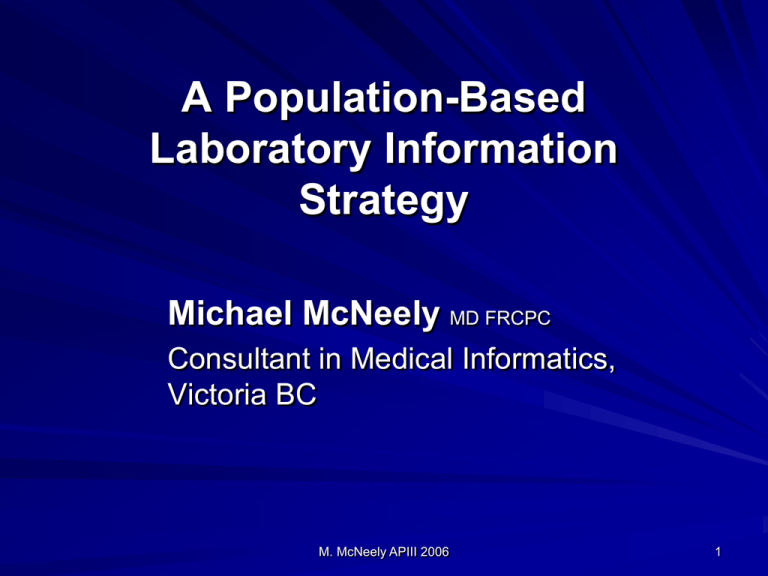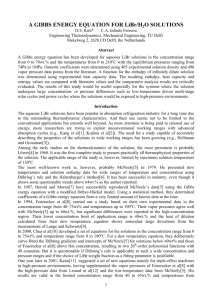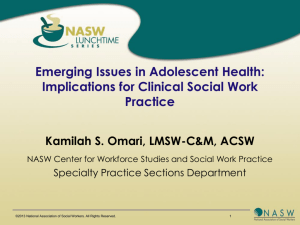Beyond the Numbers: The Knowledge
advertisement

A Population-Based Laboratory Information Strategy Michael McNeely MD FRCPC Consultant in Medical Informatics, Victoria BC M. McNeely APIII 2006 1 Overview There will be an ever-increasing need for laboratory results to be knowledge-based: to be interpreted, to guide treatment, and to smoothly integrate with the medical record. Canada Health Infoway is a government of Canada project whose goal is to have electronic medical records (EMR) for 80% of Canada’s population by 2010. The Provincial Laboratory Information Solution is a BC project to provide a unified database of all laboratory results produced in the province. These two projects are at an early stage but eventually (phase III-IV) will incorporate knowledge support. The presentation will, by way of a review, discuss the potential for these initiatives to carry forward existing programs involving laboratory utilization control, risk management, chronic disease management, telepathology, epidemiology, genominformatics, and sample management. M. McNeely APIII 2006 2 Canada Health Infoway http://www.infoway-inforoute.ca/ What is Infoway? – Canada Health Infoway Inc. invests with public sector partners across Canada to implement and reuse compatible health information systems that support a safer, more efficient healthcare system. Infoway is an independent, not-for-profit organization whose Members are Canada's 14 federal, provincial and territorial Deputy Ministers of Health. Launched in 2001, Infoway and its public sector partners have over 100 projects, either completed or underway, delivering electronic health record (EHR) solutions to Canadians – solutions that bring tangible value to patients, providers and the healthcare system. M. McNeely APIII 2006 3 Canada Health Infoway http://www.infoway-inforoute.ca/ Mission – To foster and accelerate the development and adoption of electronic health information systems with compatible standards and communications technologies on a pan-Canadian basis, with tangible benefits to Canadians. – To build on existing initiatives and pursue collaborative relationships in pursuit of our mission. M. McNeely APIII 2006 4 Canada Health Infoway http://www.infoway-inforoute.ca/ Vision – A high-quality, sustainable and effective Canadian healthcare system supported by an infostructure that provides residents of Canada and their healthcare providers with timely, appropriate and secure access to the right information when and where they enter into the healthcare system. Respect for privacy is fundamental to this vision. Goal – To have an interoperable EHR in place across 50 per cent of Canada (by population) by the end of 2009. M. McNeely APIII 2006 5 Canada Health Infoway http://www.infoway-inforoute.ca/ Components of the HER – – – – – – – – – Patient and provider registries $110 m Laboratory Results $ 150 m Medical Imaging $ 220 m Drugs $ 185 m Interoperable EHR $ 175 m Telehealth $ 150 m Public Health $ 100 m Innovation and adoption $ 60 m Infostructure $ 25 m M. McNeely APIII 2006 6 Evolution of EHR Order entry and results viewing for laboratory tests, medications and images. Alert notification (eg. duplicate tests, drug interaction) Provisioning of leading practices (i.e., CPG’s) Scheduling Functionality and Value Chain Optimization Generation 3 plus complex Decision Support Generation 4 The Mentor Patient demographics Provider demographics Generation 3 Location demographics The Helper Encounters Generation 2 The Documenter Generation 1 The Foundation Enablers Results Viewing Laboratory test results Dispensed medications Diagnostic image results Includes investments to support project management, user-adoption, change management, knowledge transfer, standards and benefits evaluation, representing 30% of program investments overall End of 2009 M. McNeely APIII 2006 7 Canada Health Infoway http://www.infoway-inforoute.ca/ Progress to date – Standards adoption: HL 7 LOINC SNOMED CT – Provincial Projects Ontario Others British Columbia M. McNeely APIII 2006 8 BC - The Provincial Strategy http://www.healthservices.gov.bc.ca/cpa/publications/ehealth_framework.pdf An HER provides each British Columbian with a secure and private lifetime record of their key health history and care within the health system. The record is available electronically to authorized health care providers and the individual anywhere, anytime, in support of highquality care. For more information on the Electronic Health Record, please see: http://healthnet.hnet.bc.ca/index.html M. McNeely APIII 2006 9 Provincial Laboratory Information Solution (PLIS) Planning and development activities to support Technology Transformation are being led by a dedicated PLIS Office within the PLCO, working with the Ministry of Health’s Knowledge Management Branch. A joint PLCO/Ministry strategy which will lead to the creation of a Provincial Laboratory Information Solution (PLIS) for British Columbia. The overall guiding vision behind the creation of a Provincial Laboratory Information Solution (PLIS) for British Columbia is to provide access to clinical laboratory information (results, orders and decision support) to care providers at the point of care anywhere in British Columbia. PLIS is also a leading initiative within the Ministry of Health's broader E-Health strategy to develop the Electronic Health Record and support IT infrastructure for health care in BC. The Provincial Laboratory Information Solution (PLIS) will: provide a standardized province-wide approach to presenting a patient's lab test results M. McNeely APIII 2006 10 Provincial Laboratory Information Solution (PLIS) electronically distribute lab test results to ordering and/or copied physicians make historical lab test results from both public and private laboratories within the province available to physicians create an electronic lab test ordering system with decision support tools improve the ability to aggregate laboratory information in order to support both administrative and clinical decision-making provide a provincial capacity to measure and manage the provision and utilization of laboratory services contribute to the realization of the provincial Electronic Health Record (EHR) Through the use of technology and standards, the new system will ensure laboratory information is: of a high quality, available to authorized health care providers and administrators throughout the province, part of each patient's provincial Electronic Health Record M. McNeely APIII 2006 11 Provincial Laboratory Information Solution (PLIS) Features Organizational structure Unique bid process – Joint Services RFP Development Time frame FUTURE COMPONENTS OF INTEREST Data Mining Clinical Decision / Knowledge Support Telepathology M. McNeely APIII 2006 12 Data Mining Utilization Control Number 5000 4500 4000 M. McNeely APIII 2006 3500 3000 2500 2000 1500 1000 500 >=100 10.0-19.9 20.0-49.9 <40 50.0-99.9 9.0-9.4 9.5-9.9 8.0-8.4 8.5-8.9 7.0-7.4 7.5-7.9 5.5-5.9 6.0-6.4 60-70 6.5-6.9 4.0-4.4 4.5-4.9 PSA Value 5.0-5.4 3.0-3.4 3.5-3.9 1.5-1.9 2.0-2.4 2.5-2.9 0-0.49 1.0-1.4 0 0.5-0.99 – Reduce unnecessary duplication of testing – Ensure adherence to utilization protocols – Facilitate data evaluation in order to design utilization strategies 13 Chronic Disease Management – Clinical Practice Guidelines Provide objective data for CPG development Outcomes analysis Follow-up of adherence Follow-up for outcomes studies Makes more elaborate CPGs possible – Disease epidemiology – Assist individual physician’s patient tracking (e.g. lists of diabetics in a physician’s practice). – Provide physician reminders re chronic disease patient reviews – Provide availability to a “package” of physician specific database searches on their own patients (e.g. a list of all “registered” diabetics in a given practice with statistics on their frequency of A1C testing compared to provincial norms). – Patient reminders M. McNeely APIII 2006 14 Special Disease Registries/Services – Automated development of registries of diseases characterized by laboratory test results (e.g. hemoglobinopathies, hypercholesterolemia, diabetes, hemochromatosis, and many others as genetic testing expands) – Specialized knowledge support tools and information for both physicians and patients – “Mailing list” of physicians/patients to be informed when new information becomes available. Epidemiology – Classic infectious disease epidemiology (but closer to “real-time”) – Real-time epidemiology for epidemics (e.g. SARS) and bioterrorism – Chronic disease epidemiology (non-infectious) Health Care System Management – – – – – Outcomes data Utilization management Population trends Test usage and deployment of resources Physician ordering profiles M. McNeely APIII 2006 15 In 1982 I gave a talk on this very same subject. I covered the following types of automated interpretations. Level 1: Standard comment on every report of a specific test. Level 2: Result specific comment: 1-test. Level 3: Result specific comment: 2-or more tests, over time, or other clinical information Level 4: More sophisticated approaches. Now, in 2006 we haven’t managed Levels 1-3 completely but we’re now looking at Level 4 and various projects may bring Level 4 to fruition within the next few years. M. McNeely APIII 2006 16 “Canned” Comments GOOD THINGS Demonstrated ability to change physician behaviour Demonstrated ability to enhance use of laboratory testing (e.g. utilization, diagnosis) CAUTIONS Limited clinical information Comment added whether needed or not Consume space on a paper report Paper report has a rigid format Some doctors feel threatened/insulted Patient overreaction (patient access) M. McNeely APIII 2006 17 Human Generated Comments Questions: – Are the interpretations part of the legal report? – Should the interpretations be added to EMR? – Who should be permitted to prepare such interpretations? Human generated reports have error rate of up to 50% (Lim Clin Chem 2004) Marshall & Challand (Ann Clin Biochem 2000) – Variation amongst interpreters – Communication style variable – Clinical information available is not always appropriate to the test being interpreted – Little feedback regarding usefulness – Interpretations should be recipient specific M. McNeely APIII 2006 18 Laposata (Clin Chem 2004; 50: 471) Laposata has championed the need for humangenerated, patient-specific narrative interpretations He has criticized the “canned” comment BUT he compares Apples and Oranges Laposata makes the case for why Knowledge Support is needed. M. McNeely APIII 2006 19 Knowledge Support a.k.a. Clinical Decision Support Two forms: – Static: PubMed, Lab Tests On-Line, ARUP – Dynamic or CARTKS (Context Appropriate Real Time Knowledge Support) Specific Interpretations M. McNeely APIII 2006 20 The “Case” for Knowledge Support / Clinical Decision Support Hundreds of publications have demonstrated its potential usefulness Several publications have pointed out potential problems but none has undercut the basic premise. Clinical Practice Guidelines: – Ever increasing numbers – Poorly applied (~ 25% adherence) – Limited complexity M. McNeely APIII 2006 21 “It is likely that when electronic knowledge support tools become a standard feature of medical practice, the protocol and CPG approach will be maximized.” McNeely Clinics of Laboratory Medicine 2002; 22: 1-10 “It is so apparent that computerization will enhance the application of CPGs that it may be unethical to continue to perform trials to answer this question.” Ellson and Connolly JAMA 1998; 279: 989. “To be widely accepted by practicing clinicians, computerized support systems for decision making must be integrated into the clinical work flow. They must present the right information, in the right format, at the right time, without requiring special effort.” James BC NEJM 1999; 340: 1202. M. McNeely APIII 2006 22 Ripple-Down Rules Developed by Paul Compton and Gordon Edwards of St. Vincent’s Hospital, Sydney AU Original system PIERS Now marketed by Pacific Knowledge Systems http://www.pks.com.au/ as LabWizard™ Rule-Based but no knowledge engineer M. McNeely APIII 2006 23 Ripple-Down Rules Knowledge Base & Inference Engine Lab Completes Test Verified Result Combination? No Yes LIS Reports: Result And Interpretation Result Combo Interpreted Integrator M. McNeely APIII 2006 24 LabWizard (example) M. McNeely APIII 2006 25 BloodLink Clin Chem 2002; 48: 605. Marc van Wijk MD PhD Delft, The Netherlands M. McNeely APIII 2006 26 M. McNeely APIII 2006 M. McNeely APIII 2006 M. McNeely APIII 2006 M. McNeely APIII 2006 BloodLink – Evaluation 50 GPs Test reduction Two Groups of 19.6% 1-Year BloodLink Restricted CONTROL BloodLink Guideline TEST Number of Number of Tests Requested Requisitions 12,786 87,634 12,700 70,479 M. McNeely APIII 2006 31 Laboratory Advisory System Chang E, McNeely MDD, Gamble K. Strategies for choosing the next test in an expert system. Proceedings of the congress on medical informatics. AAMSI 1984; 2:198-202. McNeely MDD, Smith B. An interactive expert system for the ordering and interpretation of laboratory tests to enhance diagnosis and control utilization. Canadian Medical Informatics. May/June 1995;16-19. Smith BJ and McNeely MDD. The Influence of an Expert System for Test Ordering and Interpretation on Laboratory Investigations. Clinical Chemistry 1999; 45(8): 1168-1175. Clinical-Laboratory.com Old Marlebone Rd, London, England M. McNeely APIII 2006 32 M. McNeely APIII 2006 33 M. McNeely APIII 2006 34 M. McNeely APIII 2006 35 M. McNeely APIII 2006 36 M. McNeely APIII 2006 37 M. McNeely APIII 2006 38 M. McNeely APIII 2006 39 M. McNeely APIII 2006 40 M. McNeely APIII 2006 41 M. McNeely APIII 2006 42 M. McNeely APIII 2006 43 Results of a trial Paper Computer Mean # of tests 32.7 17.8 Mean # of samples 7.5 5.8 $ 232 $ 194 Turnaround time (days) 3.2 1 Diagnostic accuracy 66% 100% 12 0 Cost ($ CDN) Referrals to specialists M. McNeely APIII 2006 44 The LAS – Study Conclusion The development of test ordering strategies can be enhanced. The interpretation of the test results can be enhanced. A statistical database of diagnosis, clinical information, test orders, and results can be readily derived. Such information is unique and is available for optimizing and developing testing strategies and for laboratory management. M. McNeely APIII 2006 45 The LAS – study conclusion (con’t) An appropriate search of the database would enable clinician-targeted education and utilization feedback to be derived. Examination of the database at the time of ordering would enable the development of a module to identify unnecessary, duplicate testing. M. McNeely APIII 2006 46 Contextualized Report Dr. Jonathan Kay (Oxford) Drs. Bruce Friedman and Jules Berman Lab Medicine 2006; 37: 121. M. McNeely APIII 2006 47 Smith, John H. Male 46 yoa Dr. Louis Pasteur DOS June 7, 2006 23957988-1 Reference Interval Test Name Result Alkaline Phosphatase 128 20 – 105 U/L M. McNeely APIII 2006 48 Smith, John H. Male Dr. Louis Pasteur DOS June 7, 2006 Test Name Result 46 yoa 23957988-1 Reference Interval 128 20 – 105 U/L ALERT !! Patient is taking Chlorpromazine Analytical Information – Alkaline Phosphatase which is known to cause Cholestasis with 1. Laboratory validation studies increased Alk Phos. 2. Method reference 3. Instrument validation studies 4. Proficiency testing record 5. Complete Bibliography –Click here Alkaline Phosphatase M. McNeely APIII 2006 49 Smith, John H. Male 46 yoa Dr. Louis Pasteur DOS June 7, 2006 23957988-1 Reference Interval Test Name Result Alkaline Phosphatase 128 20 – 105 U/L Analytical Information – Alkaline Phosphatase 1. 2. 3. 4. Laboratory validation studies Method reference Instrument validation studies Proficiency testing record M. McNeely APIII 2006 50 Smith, John H. Male 46 yoa Dr. Louis Pasteur DOS June 7, 2006 23957988-1 Reference Interval Test Name Result Alkaline Phosphatase 128 20 – 105 U/L Reference Interval – Alkaline Phosphatase 1. 2. 3. 4. Literature Reference In-house studies Notes Graphical Presentation M. McNeely APIII 2006 51 Smith, John H. Male 46 yoa Dr. Louis Pasteur DOS June 7, 2006 23957988-1 Reference Interval Test Name Result Alkaline Phosphatase 128 20 – 105 U/L Reference Interval – Alkaline Phosphatase 1. 2. 3. 4. Literature Reference In-house studies Notes Graphical Presentation M. McNeely APIII 2006 52 Smith, John H. Male 46 yoa Dr. Louis Pasteur DOS June 7, 2006 23957988-1 Reference Interval Test Name Result Alkaline Phosphatase 128 20 – 105 U/L Interpretation – Alkaline Phosphatase 1. 2. 3. 4. Causes of an increased Alkaline Phosphatase Causes of an decreased Alkaline Phosphatase Specific Interpretation of this result Request a personal consultation on this result M. McNeely APIII 2006 53 Genoinformatics Screening tests PCR Testing Proteomics Physician Understanding Patient Information - Counselling Family Studies Long-term Follow-up New Knowledge M. McNeely APIII 2006 54 Knowledge Assembly Major problem is the creation/assembly of Knowledge Support tools (e.g. 1 rule per hour or committee) Must have AUTOMATED knowledge assembly Must have generic Inference Engines Must rely on the integrative intelligence of the user M. McNeely APIII 2006 55 Inference Engine IF Alkaline Phosphatase > ULN AND Age > 70 THEN Consider Paget’s Disease M. McNeely APIII 2006 3+ 56 Knowledge Assembly Facts: ND most 2 – From Electronic Medical Record important – Added at time of ordering – Added during interpretation slide Rules – Grunt approach – Formal Committees (worldwide?) Constructed – CPGs – Wikipedia format – Medical Literature Automated – Database M. McNeely APIII 2006 57 Wikipedia M. McNeely APIII 2006 58 Medical Literature M. McNeely APIII 2006 59 Data Mining M. McNeely APIII 2006 60 Telepathology Goals of Province-wide program – VISION Organizational structure Overview Standards M. McNeely APIII 2006 61 62 Evolution Step •Feasibility trials of S&F •Thinking about V Infrastructure STDS Accred Rules Privacy PLIS PACS Existing •Education Record of image (not image) •Routine S&F Linkage to API LIS •Some trial virtual •Mature use of S &F •Some HA use V routinely for limited APS trial HA-HA HL7 SNOWMED.CT LOINC Intra Dept Storage Licensing ? DICOM 2009 Image Repository •Mature S&F •Routine, limited ApV, routine HAHA •Additional Aps & more common use PACS 63 Most Conclusion important The EHR 2009-2010 – Clinical Decision slide Support: If Decision Support is expected in 2 4 years then planning MUST start now. If Knowledge Support is to be meaningful then building the Knowledge Bases must begin soon – but, we will need to know how they will be executed and what the Inference Engine will look like. If Laboratory Professiolnals expect to be involved in the interpretation of the results they produce they must get involved in the development of the Decision Support modules or risk being disintermediated. M. McNeely APIII 2006 64 Conclusion M. McNeely APIII 2006 65





